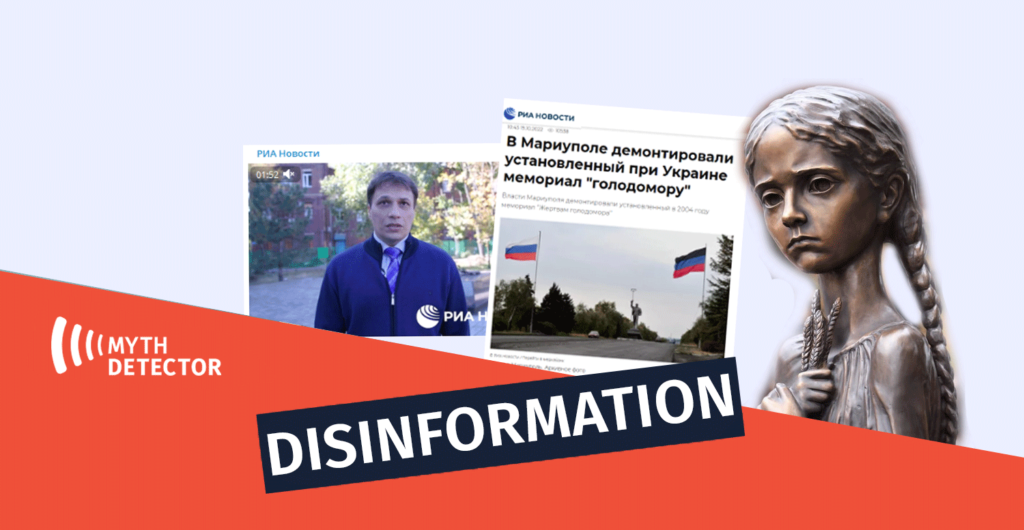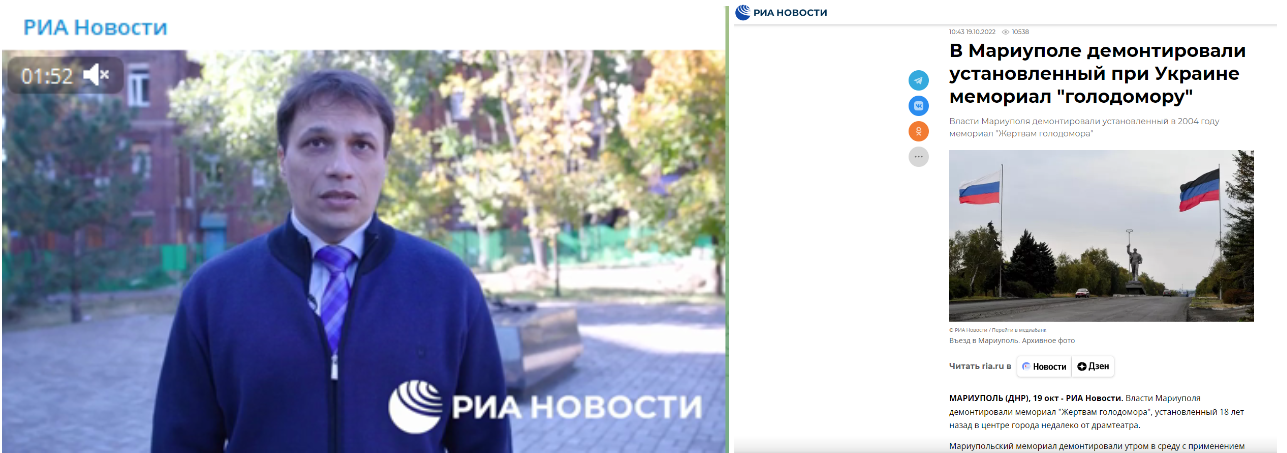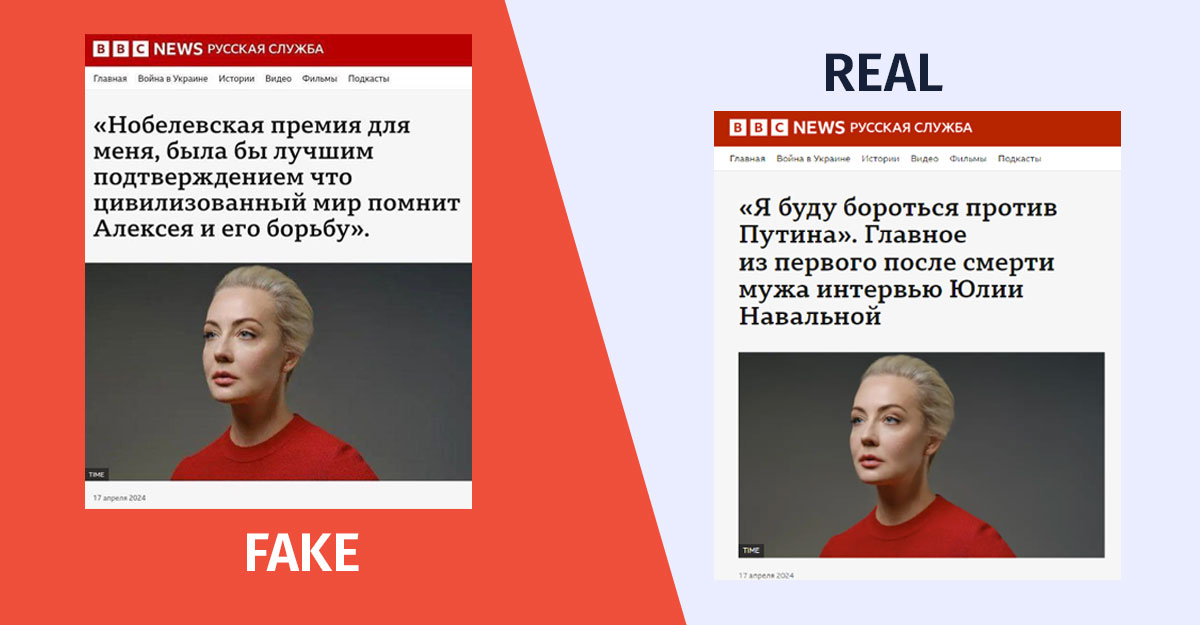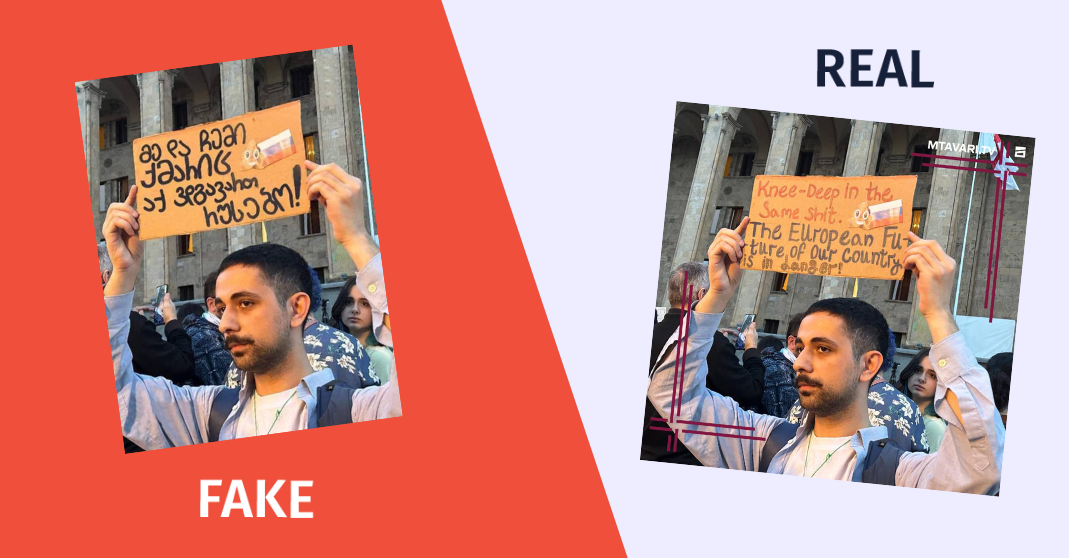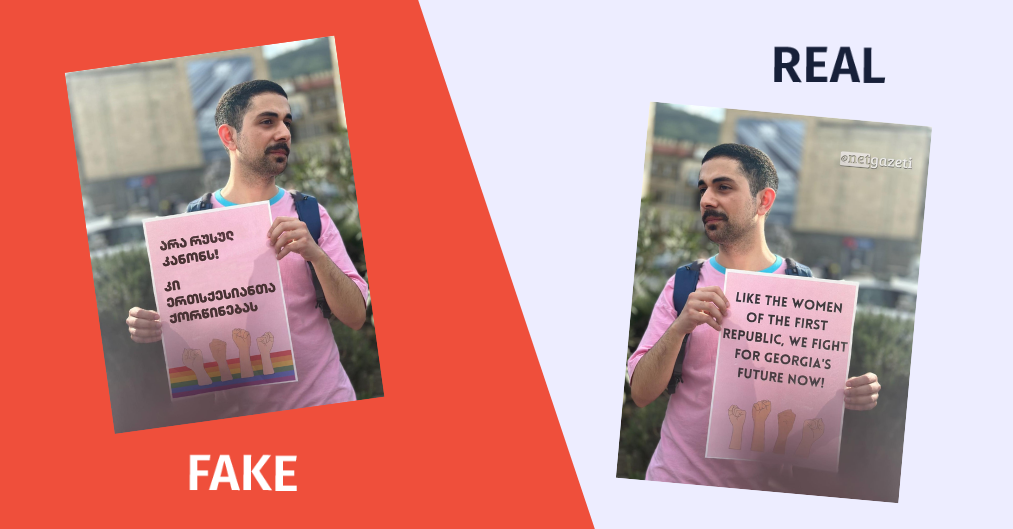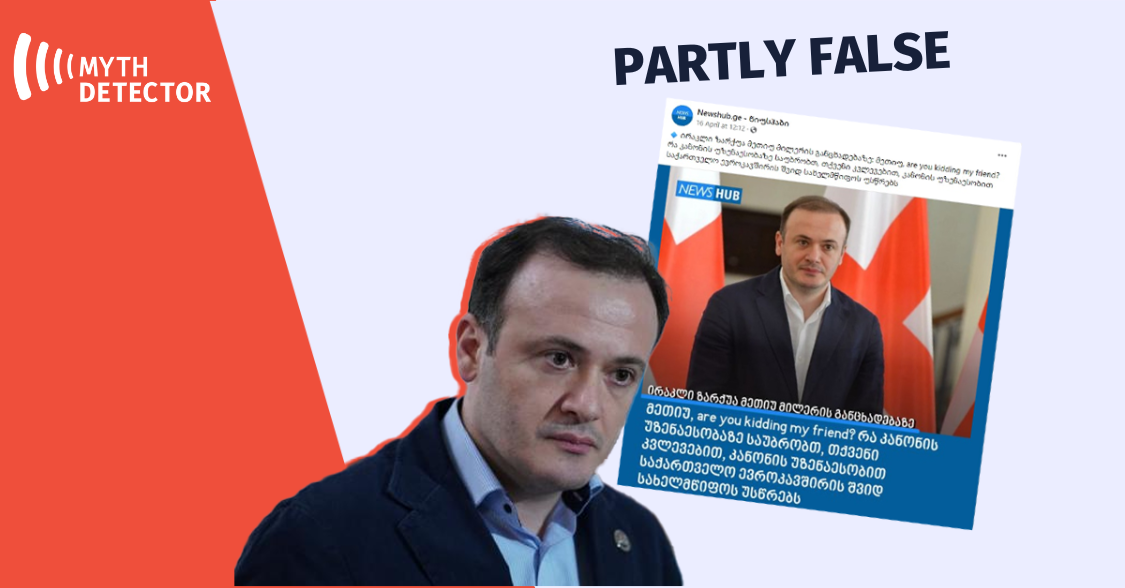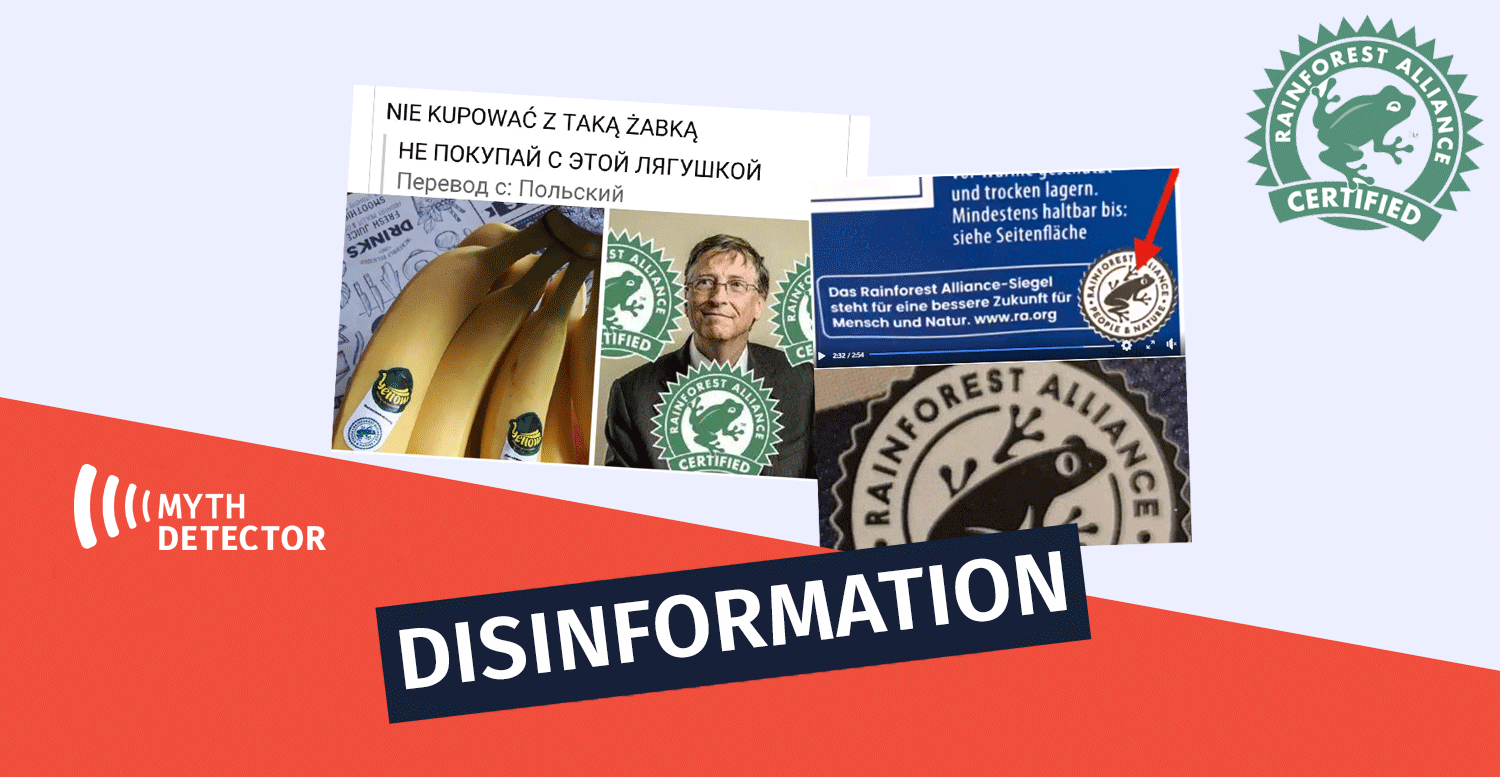On October 10, 2022, a memorial to the Holodomor tragedy was taken down in the occupied Mariupol. Shortly after, Kremlin propaganda media RIA Novosti prepared a story on the topic, voicing a number of claims attempting to deny the Holodomor tragedy. The story featured Artyom Bobrovsky, head of the department at Donetsk National University, stating that according to “historical sources,” famine in the regions of the South of Russia and then the Soviet Union was a recurring event, and as a result of the famine in 1932-33, the largest number of casualties was not in Ukraine, but in other regions of the USSR. The story also featured Yevgenia Korotova, the representative of the so-called civil society organization “Young Republic”, who noted that the “governing body” of the city is not fighting against the historical monument, but is removing the “symbol of disinformation created at the state level.” Artyom Bobrovsky’s comments regarding the Holodomor were also covered by other Russian media outlets. (1,2,3)
Disinformation about the Holodomor has been circulating for decades. In fact, the famine of 1932-1933 in Ukraine was not caused by natural events, as the tragedy was the result of Stalin’s deliberate policy. Falsifying the number of victims of the event and connecting the famine with natural phenomena was initially part of the propaganda of the Soviet Union. The method is now acquired by Russian propaganda, which aims to hide the crimes of Stalin’s regime and deny the genocide.
-
The famine of 1932-1933 in Ukraine was not caused by natural events, as the tragedy was the result of Stalin’s deliberate policy
The famine that devastated Ukraine in 1932-33 was not caused by a natural lack of resources but was initiated by the regime’s specific actions, including the confiscation of seed material from the peasants on Stalin’s orders and the closure of Ukraine’s borders. On January 11, 1933, at the Joint Plenum of the Central Committee, Stalin announced that there was significantly more bread in the Soviet Union in 1932 compared to 1931.
Stalin: “No one can deny that the gross grain harvest in 1932 was greater than in 1931, when the drought in the five main regions of the northeast of the USSR significantly reduced the grain balance of the country. Of course, in 1932, we also had some crop losses due to unfavorable climatic conditions in the Kuban and Terek, as well as in some regions of Ukraine. But there can be no doubt that these losses do not amount to even half of those losses that took place in 1931 due to drought in the northeastern regions of the USSR.”
A 1988 investigative report to the US Congress by the “Commission on the Ukrainian Famine” stated that there was no drought in Ukraine in 1932, describing the Holodomor as a “man-made famine.”
American historian Timothy D. Snyder in his book “Bloodlands: Europe Between Hitler and Stalin” describes the causes of the great famine in Ukraine in detail. According to Snyder, the famine in Ukraine in 1933 was the result of Stalin’s five-year plan of 1928-32, which involved forced collectivization and repression of wealthy peasants, aka kulaks. By the beginning of 1931, 32127 families were deported from Soviet Ukraine.
Important moments of Stalin’s policy in Ukraine:
- In 1930, peasants in Ukraine harvested abundant wheat crops, which led to increased wheat requisitions from Ukraine in 1931.
- Bad weather conditions during early flowering significantly reduced crop yields in 1931. Ukrainian party leader, Stanisław Kosior wrote in the report of that year that it was impossible to fulfil the requisition plan, but Moscow believed that peasants were hiding and stealing the crops.
- Stalin ordered on December 5, 1931, that collective farms that had not yet fulfilled their annual requirements must surrender their seed grain. As a result of this policy, the next year, peasants had no seed grains to plant crops.
- In early 1932, the Ukrainians asked Stalin to call in the Red Cross, but he rejected the request for humanitarian aid.
- Along with the famine in Ukraine, Stalin and other top officials believed that the hunger was caused by lazy peasants and that stricter rules of wheat requisition should have been imposed to punish them.
- According to the law enacted on August 7, 1932, agricultural products were declared as state property. Storing food without permission was considered stealing.
- Surveillance towers were erected in cornfields in August 1932 to intensify control over peasants.
- By the decision of November 8, 1932, those collective farms, which failed to fulfil annual plans of requisition, would be deprived of the right to participate in the Soviet economy.
- By the decision of November 18, 1932, Ukrainian peasants were banned to store wheat reserves remaining after requisition.
- A meat fine came into effect on November 20, 1932. Those peasants, who failed to fulfil a wheat plan, had to compensate it with meat.
- By the decision of November 28, 1932, those collective farms that failed to fulfil a plan, were imposed an obligation to hand over 15-times more wheat.
- From December 5, 1932, the famine was considered a conspiracy by Ukrainian nationalists. Based on this decision, everyone, who did not fulfil the plan, was considered a traitor.
- By the end of 1932, seed grains were seized from peasants.
- From 1933, Ukraine’s borders were closed to prevent peasants from running away. From January 23, 1933, the sale of tickets for travelling a long distance was prohibited.
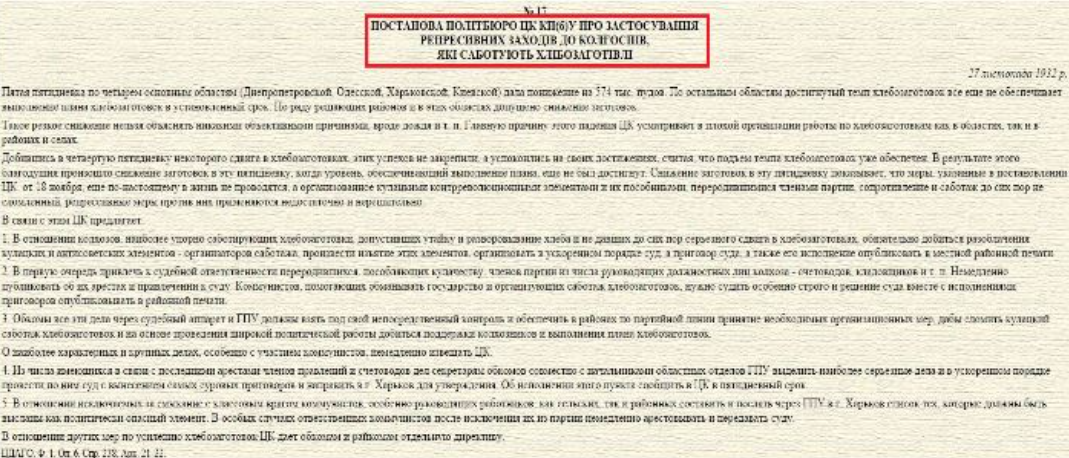 Photo: The decision of November 27, 1932, about the repressions imposed on peasants
Photo: The decision of November 27, 1932, about the repressions imposed on peasants
Source: National Archive of Ukraine
-
The number of Holodomor victims ranges from 3.9 to 7 million. By falsifying the population census in the USSR, Stalin’s regime hid the real number
According to various historical sources, the number of Holodomor victims varies between 3.9-7 million. Ukrainian Holodomor researchers note that Soviet historians reduced the number of victims to 2.5-3.5 million. As a result of the disclosure of archive data of the USSR, researchers estimate that 6.8-7.5 million people died as a result of the Holodomor. It should be noted that in the story of Ria Novosti, Bobrovsky says that in the 1930s, more people died of famine in other regions of the USSR, citing Kazakhstan as one of the examples. In Kazakhstan in 1930-33, as a result of Stalin’s repressive policy, at least 1.5 million people died from an artificially arranged famine. Manipulating the number of Holodomor victims has been part of Soviet and Russian propaganda for years. Reducing the number of victims and comparing it with other tragedies serves to deny the genocide and devalue its gravity.
- How did the Stalin regime hide the number of victims?
The census carried out in the Soviet Union on January 6, 1937, prompted Stalin to arrest Mikhail Kurman, Olimpy Kvitkin, Lazar Brand and Ivan Oblomov, the main statistical professionals of the Central Statistics Office; some of them were later executed. The census results showed lower population figures than anticipated by Stalin – 162 million people. Speaking at the Communist Party’s XVI Congress on June 27, 1930, Stalin said that the Soviet population was annually increasing by 3 million. If the results of the 1926 census showed the Soviet Union’s population at 147 million, according to Stalin’s calculations, by 1937, this figure should have increased to 180 million.
Ultimately, Stalin annulled the results of the 1937 census and held a new census in 1939, the results of which showed the Soviet Union’s population at 170 million.
Before 1937, a six-million decline in the Soviet Union’s population was reported in 1934 as a result of annual calculations made by the Central Statistics Office. Speaking at the Communist Party’s XVII Congress in January 1934, Stalin said that at the beginning of the year, the USSR population was 168 million. However, the table below shows that this figure has been increased artificially, and it does not comply with the figure of annual calculations made by the Central Statistics Office. The real figure amounted to 154 million at the beginning of 1934 against 162.3 million a year earlier. Contrary to this figure, the figures desirable to Stalin were released in 1934, showing a three-million growth.

-
International recognition of the Holodomor
The European Council and other international organizations declare Holodomor as a crime committed against humanity, while 17 countries recognize it as genocide.
The PACE resolution of 2010 describes the Holodomor, the result of policies pursued by the Stalinist regime, as a crime against humanity.
PACE resolution of 2010: “It strongly condemns the cruel policies pursued by the Stalinist regime, which resulted in the death of millions of innocent people, as a crime against humanity.”
17 states recognized Holodomor as an act of genocide against the Ukrainian people: USA, Argentina, Australia, Canada, Columbia, Czech Republic, Estonia, Ecuador, Georgia, Hungary, Latvia, Lithuania, Mexico, Paraguay, Peru, Poland, and the Slovak Republic.
The Holodomor was recognized as a tragedy/crime against humanity in various resolutions adopted by international organizations.
- The European Parliament resolution of 2008: “recognizes the Holodomor (the artificial famine of 1932-1933 in Ukraine) as an appalling crime against the Ukrainian people, and against humanity.”
- Joint statement to the UN General Assembly: “The Great Famine of 1932-1933 in Ukraine (Holodomor), which took from 7 million to 10 million innocent lives, became a national tragedy for the Ukrainian people.”
- PACE resolution of 2010: “It strongly condemns the cruel policies pursued by the Stalinist regime, which resulted in the death of millions of innocent people, as a crime against humanity.”
- OSCE resolution of 2008: “The Holodomor of 1932 and 1933 was the mass starvation brought about by the cruel deliberate actions and policies of the totalitarian Stalinist regime;
Denial of the Holodomor in Ukraine is part of Soviet propaganda
Denial of the Holodomor, as well as the tactic of manipulating the number of the Holodomor victims, is part of Soviet propaganda. Initially, the Soviet government did its best to conceal the information on Ukraine’s famine from other republics. Just for this purpose, Ukraine’s borders were closed in 1933, and Ukrainian peasants were banned to travel a long distances. The famine was portrayed as a conspiracy by Ukrainian nationalists and people’s enemies. In an interview with British investigative journalist, Gareth Jones in 1933, the Soviet Foreign Minister denied the Holodomor in Ukraine.
One of the first Western Holodomor deniers was Walter Duranty, the winner of the 1932 Pulitzer prize in journalism and the head of the New York Times Moscow Bureau, who wrote that “there is no actual starvation or deaths from starvation”, that caused huge harm to spread the truth on the famine in Ukraine.
To conceal reality, Soviet propaganda used the method of “a Potemkin village”. Before the visit of Edouard Herriot, the French Radical leader, twice premier of his country, to Kyiv, the population was required to clean the streets and decorate the houses. Shop windows were filled with food, but police dispersed or arrested even local citizens, who pressed too close. Homeless children, beggars and starving people disappeared. The newspaper Pravda wrote on September 13, 1933, that Herriot categorically denied what the bourgeois press wrote about the Soviet famine.
The article has been written in the framework of Facebook’s fact-checking program. You can read more about the restrictions that Facebook may impose based on this article via this link. You can find information about appealing or editing our assessment via this link.
Read detailed instructions for editing the article.
Read detailed appeal instructions

















